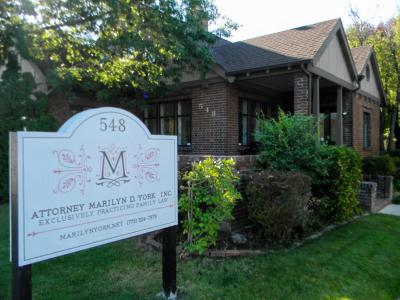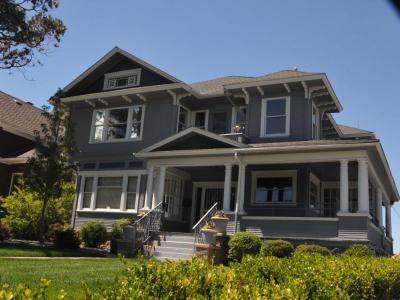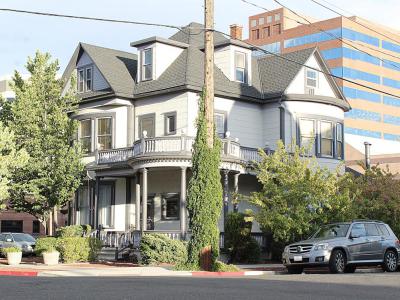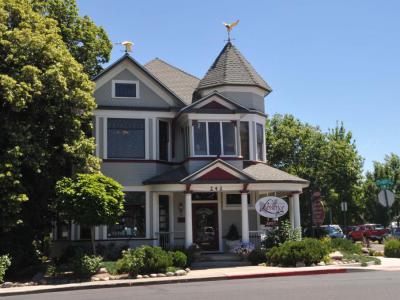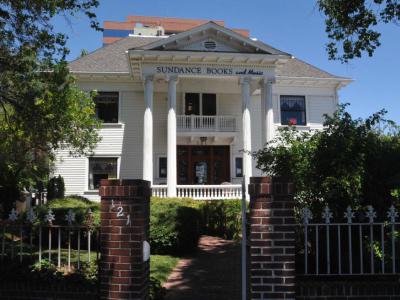Historical Houses Tour (Self Guided), Reno
Throughout its nearly 150-year-long history, Reno has reinvented itself several times. In the 19th century, cattle barons, mine speculators, and bank presidents favored this once arid little town as a place of residence. Building their mansions with extensive gardens on the high bluff above the Truckee River, they eventually transformed it into what author Walter Van Tilburg Clark later described as “The City of Trembling Leaves.”
Today one can still find in Reno a few notable houses that showcase the region's architectural styles and cultural significance. The historical architecture of Reno is diverse, ranging from the elegant Victorian and Queen Anne styles to the more modest Craftsman (aka Arts and Crafts) homes and Prairie bungalows.
At the turn of the 20th century, the Victorian style was prominent in Reno, much like the Italianate architecture which gained popularity during the mid-19th century. The Lake Mansion, one of the oldest homes in the city, built in 1877, is a notable example of a fusion between the two.
William J. Graham House, constructed in the late 1920s, showcases elements of Tudor Revival design, whereas Hawkins House, from the early 1900s, is a fine piece of Colonial Revival.
The Joseph H. Gray House, built in 1911, is a beautiful Queen Anne-style home. As for the Nortonia Boarding House, the style of this building reflects a mix of Queen Anne and Colonial Revival influences.
Every historical house is a window into the past, a tangible piece of history that tells a story of its time, its people, and the architectural heritage of a city. In the shadow of the Sierra Nevada mountains, Reno's historical houses stand as a testament to the city's growth, cultural identity, and the preservation of its architectural legacy. If you wish to immerse yourself in the artistry and craftsmanship of yesteryears, we invite you to this self-guided walking tour.
Today one can still find in Reno a few notable houses that showcase the region's architectural styles and cultural significance. The historical architecture of Reno is diverse, ranging from the elegant Victorian and Queen Anne styles to the more modest Craftsman (aka Arts and Crafts) homes and Prairie bungalows.
At the turn of the 20th century, the Victorian style was prominent in Reno, much like the Italianate architecture which gained popularity during the mid-19th century. The Lake Mansion, one of the oldest homes in the city, built in 1877, is a notable example of a fusion between the two.
William J. Graham House, constructed in the late 1920s, showcases elements of Tudor Revival design, whereas Hawkins House, from the early 1900s, is a fine piece of Colonial Revival.
The Joseph H. Gray House, built in 1911, is a beautiful Queen Anne-style home. As for the Nortonia Boarding House, the style of this building reflects a mix of Queen Anne and Colonial Revival influences.
Every historical house is a window into the past, a tangible piece of history that tells a story of its time, its people, and the architectural heritage of a city. In the shadow of the Sierra Nevada mountains, Reno's historical houses stand as a testament to the city's growth, cultural identity, and the preservation of its architectural legacy. If you wish to immerse yourself in the artistry and craftsmanship of yesteryears, we invite you to this self-guided walking tour.
How it works: Download the app "GPSmyCity: Walks in 1K+ Cities" from Apple App Store or Google Play Store to your mobile phone or tablet. The app turns your mobile device into a personal tour guide and its built-in GPS navigation functions guide you from one tour stop to next. The app works offline, so no data plan is needed when traveling abroad.
Historical Houses Tour Map
Guide Name: Historical Houses Tour
Guide Location: USA » Reno (See other walking tours in Reno)
Guide Type: Self-guided Walking Tour (Sightseeing)
# of Attractions: 8
Tour Duration: 1 Hour(s)
Travel Distance: 1.8 Km or 1.1 Miles
Author: ellen
Sight(s) Featured in This Guide:
Guide Location: USA » Reno (See other walking tours in Reno)
Guide Type: Self-guided Walking Tour (Sightseeing)
# of Attractions: 8
Tour Duration: 1 Hour(s)
Travel Distance: 1.8 Km or 1.1 Miles
Author: ellen
Sight(s) Featured in This Guide:
- William J. Graham House
- Hawkins House
- Joseph H. Gray House
- Lake Mansion
- Nortonia Boarding House
- Tyson House
- Levy House
- Charles H. Burke House
1) William J. Graham House
The William J. Graham House is an impressive historic residence that showcases the architectural style of Tudor Revival. Constructed in 1928, this house was designed by renowned architect George A. Schastey. Its architectural and historical significance led to its inclusion on the National Register of Historic Places (NRHP) in 1983.
The William J. Graham House is primarily notable for its association with William J. Graham, a prominent figure in Nevada's gaming history and a key contributor to various colorful aspects of the state's 20th-century history. Graham played a significant role in the development of casinos, a red-light district, and various other ventures. His diverse pursuits included involvement in bootlegging and fight promotion, notably the renowned 1931 Baer-Uzcudun fight. The house served as Graham's residence for a remarkable span of 40 years, further solidifying its historical significance.
Beyond its historical importance, the William J. Graham House is distinguished by its remarkable craftsmanship and preservation. The house stands as a testament to the meticulous attention to detail and skillful artistry of its builders. Its Tudor Revival architectural style is characterized by its distinctive features, including steeply pitched roofs, decorative half-timbering, Tudor arches, and leaded glass windows. These elements contribute to the house's timeless charm and architectural appeal.
The well-preserved craftsmanship of the William J. Graham House enhances its historical and architectural significance. It serves as a tangible link to the past, allowing visitors to appreciate the artistry and dedication that went into its construction. The house's inclusion on the NRHP ensures its protection and preservation for future generations to admire and enjoy.
The William J. Graham House is primarily notable for its association with William J. Graham, a prominent figure in Nevada's gaming history and a key contributor to various colorful aspects of the state's 20th-century history. Graham played a significant role in the development of casinos, a red-light district, and various other ventures. His diverse pursuits included involvement in bootlegging and fight promotion, notably the renowned 1931 Baer-Uzcudun fight. The house served as Graham's residence for a remarkable span of 40 years, further solidifying its historical significance.
Beyond its historical importance, the William J. Graham House is distinguished by its remarkable craftsmanship and preservation. The house stands as a testament to the meticulous attention to detail and skillful artistry of its builders. Its Tudor Revival architectural style is characterized by its distinctive features, including steeply pitched roofs, decorative half-timbering, Tudor arches, and leaded glass windows. These elements contribute to the house's timeless charm and architectural appeal.
The well-preserved craftsmanship of the William J. Graham House enhances its historical and architectural significance. It serves as a tangible link to the past, allowing visitors to appreciate the artistry and dedication that went into its construction. The house's inclusion on the NRHP ensures its protection and preservation for future generations to admire and enjoy.
2) Hawkins House
The Hawkins House is a notable historic residence that has undergone various transformations over the years. Originally designed in a Colonial Revival style by Elmer Grey in 1911, the house was commissioned by Prince A. Hawkins, a member of the esteemed Hawkins family.
The Hawkins House, now home to the Nevada Interscholastic Activities Association (NIAA) offices, holds architectural significance as a fine example of Colonial Revival design. This architectural style is characterized by its symmetrical façade, classical elements, and refined detailing. Elmer Grey's expertise in creating elegant and timeless designs is evident in the graceful proportions and aesthetic appeal of the Hawkins House.
Adjacent to the Francis G. Newlands House, a designated National Historic Landmark, the Hawkins House benefits from its proximity to another renowned architectural gem. The presence of these two historic houses in close proximity enhances the architectural and historical significance of the area.
From 1978 to 1988, the Hawkins House had a distinct role as the Sierra Nevada Museum of Art, which has since been renamed the Nevada Museum of Art. During this period, the house served as a hub for artistic expression and cultural engagement in Reno. The presence of the museum further added to the significance of the Hawkins House within the community.
The Hawkins House, now home to the Nevada Interscholastic Activities Association (NIAA) offices, holds architectural significance as a fine example of Colonial Revival design. This architectural style is characterized by its symmetrical façade, classical elements, and refined detailing. Elmer Grey's expertise in creating elegant and timeless designs is evident in the graceful proportions and aesthetic appeal of the Hawkins House.
Adjacent to the Francis G. Newlands House, a designated National Historic Landmark, the Hawkins House benefits from its proximity to another renowned architectural gem. The presence of these two historic houses in close proximity enhances the architectural and historical significance of the area.
From 1978 to 1988, the Hawkins House had a distinct role as the Sierra Nevada Museum of Art, which has since been renamed the Nevada Museum of Art. During this period, the house served as a hub for artistic expression and cultural engagement in Reno. The presence of the museum further added to the significance of the Hawkins House within the community.
3) Joseph H. Gray House
The Joseph H. Gray House is a captivating historic residence with a unique architectural composition. Constructed in 1911, this house bears a fusion of architectural styles, featuring Colonial Revival details within a structure that encompasses Queen Anne-style massing.
This distinguished house holds significance not only for its architectural charm but also for its association with Joseph H. Gray, a prominent Reno department store owner. As the proprietor of a local retail establishment, Gray played an influential role in the city's commercial landscape, and his residence reflects his success and status within the community.
The Joseph H. Gray House stands as a testament to the architectural styles prevalent during its construction period. Combining elements of the Colonial Revival and Queen Anne styles, the house offers a unique and visually appealing composition. Colonial Revival details can be observed in its design, which incorporates symmetrical features, classical elements, and refined detailing. The Queen Anne-style massing adds to the house's grandeur, featuring complex rooflines, projecting bays, and an overall asymmetrical form.
In recognition of its architectural and historical significance, the Joseph H. Gray House was listed on the National Register of Historic Places in 1987. This designation acknowledges the house's contribution to the cultural heritage of Reno. The listing also includes two contributing buildings, emphasizing the importance of preserving the architectural integrity of the entire property.
This distinguished house holds significance not only for its architectural charm but also for its association with Joseph H. Gray, a prominent Reno department store owner. As the proprietor of a local retail establishment, Gray played an influential role in the city's commercial landscape, and his residence reflects his success and status within the community.
The Joseph H. Gray House stands as a testament to the architectural styles prevalent during its construction period. Combining elements of the Colonial Revival and Queen Anne styles, the house offers a unique and visually appealing composition. Colonial Revival details can be observed in its design, which incorporates symmetrical features, classical elements, and refined detailing. The Queen Anne-style massing adds to the house's grandeur, featuring complex rooflines, projecting bays, and an overall asymmetrical form.
In recognition of its architectural and historical significance, the Joseph H. Gray House was listed on the National Register of Historic Places in 1987. This designation acknowledges the house's contribution to the cultural heritage of Reno. The listing also includes two contributing buildings, emphasizing the importance of preserving the architectural integrity of the entire property.
4) Lake Mansion
The Lake Mansion is a cherished historic house that has undergone several relocations throughout its existence. Originally constructed in 1877 at the corner of Virginia and California Streets, it currently resides at 250 Court Street. The house showcases a blend of Late Victorian and Italianate architectural styles and holds a significant association with Myron Lake, one of Reno's founders, who acquired the property in 1879.
The Lake Mansion has witnessed a remarkable journey. In 1971, the house was moved to the grounds of the Convention Center, located at the corner of Kietzke Lane and Virginia Street. Subsequently, in 2004, it underwent another relocation to its present location. Despite these moves, the Lake Mansion's historical value was recognized, and it was listed on the National Register of Historic Places in 1972.
The house features a hipped roof with a widow's walk, characteristic of its era. A charming veranda wraps around three sides of the house, adding to its allure and providing a welcoming outdoor space.
In 2008, an adjacent enclosed garden pavilion was constructed to complement the Lake Mansion. This pavilion serves as a venue for event rentals and houses classes and events organized by Arts for All Nevada. The non-profit organization owns and operates the Lake Mansion, ensuring its preservation and fostering artistic opportunities throughout the community.
With its fusion of Late Victorian and Italianate architectural elements, the Lake Mansion represents the craftsmanship and architectural style of its time. The adjacent garden pavilion further enhances the property's value, providing a space for community engagement and artistic expression.
Today, the Lake Mansion is not only a historic landmark but also a vibrant center for arts and cultural activities. Its relocation, preservation, and use by Arts for All Nevada exemplify the community's commitment to honoring and celebrating its past while fostering creativity and inclusivity.
The Lake Mansion has witnessed a remarkable journey. In 1971, the house was moved to the grounds of the Convention Center, located at the corner of Kietzke Lane and Virginia Street. Subsequently, in 2004, it underwent another relocation to its present location. Despite these moves, the Lake Mansion's historical value was recognized, and it was listed on the National Register of Historic Places in 1972.
The house features a hipped roof with a widow's walk, characteristic of its era. A charming veranda wraps around three sides of the house, adding to its allure and providing a welcoming outdoor space.
In 2008, an adjacent enclosed garden pavilion was constructed to complement the Lake Mansion. This pavilion serves as a venue for event rentals and houses classes and events organized by Arts for All Nevada. The non-profit organization owns and operates the Lake Mansion, ensuring its preservation and fostering artistic opportunities throughout the community.
With its fusion of Late Victorian and Italianate architectural elements, the Lake Mansion represents the craftsmanship and architectural style of its time. The adjacent garden pavilion further enhances the property's value, providing a space for community engagement and artistic expression.
Today, the Lake Mansion is not only a historic landmark but also a vibrant center for arts and cultural activities. Its relocation, preservation, and use by Arts for All Nevada exemplify the community's commitment to honoring and celebrating its past while fostering creativity and inclusivity.
5) Nortonia Boarding House
The Nortonia Boarding House is a historic landmark with a rich history and distinctive architectural features. Constructed around 1900-1904, this elegant structure originally served as a residential dwelling. However, in 1906, it underwent significant modifications when it was purchased by Norton, who transformed it into a boarding house and expanded its size. The Nortonia Boarding House showcases a unique blend of architectural styles, primarily displaying the characteristics of the Queen Anne style, while also incorporating elements of Colonial Revival architecture.
As one of the few remaining Queen Anne houses in Reno, the Nortonia Boarding House holds great significance and has garnered recognition for its architectural beauty. It was duly acknowledged for its historical and architectural importance when it was added to the National Register of Historic Places in 1983.
The Queen Anne style, prevalent in the design of the Nortonia Boarding House, is characterized by its asymmetrical shape, elaborate ornamentation, and rich detailing. This architectural style emphasizes verticality with multiple gables and dormers, giving the building a sense of grandeur. The façade of the Nortonia Boarding House is adorned with decorative elements such as intricately carved woodwork, ornate brackets, and vibrant paint colors, reflecting the exuberance and creativity of the Queen Anne style.
In addition to its Queen Anne features, the Nortonia Boarding House also incorporates elements of the Colonial Revival style. This architectural movement, popular during the late 19th and early 20th centuries, drew inspiration from the colonial period in American history. It sought to revive and reinterpret the architectural forms of that era, often incorporating symmetrical designs, classical details, and front porches with classical columns. The inclusion of Colonial Revival elements in the Nortonia Boarding House further adds to its architectural diversity and visual appeal.
As one of the few remaining Queen Anne houses in Reno, the Nortonia Boarding House holds great significance and has garnered recognition for its architectural beauty. It was duly acknowledged for its historical and architectural importance when it was added to the National Register of Historic Places in 1983.
The Queen Anne style, prevalent in the design of the Nortonia Boarding House, is characterized by its asymmetrical shape, elaborate ornamentation, and rich detailing. This architectural style emphasizes verticality with multiple gables and dormers, giving the building a sense of grandeur. The façade of the Nortonia Boarding House is adorned with decorative elements such as intricately carved woodwork, ornate brackets, and vibrant paint colors, reflecting the exuberance and creativity of the Queen Anne style.
In addition to its Queen Anne features, the Nortonia Boarding House also incorporates elements of the Colonial Revival style. This architectural movement, popular during the late 19th and early 20th centuries, drew inspiration from the colonial period in American history. It sought to revive and reinterpret the architectural forms of that era, often incorporating symmetrical designs, classical details, and front porches with classical columns. The inclusion of Colonial Revival elements in the Nortonia Boarding House further adds to its architectural diversity and visual appeal.
6) Tyson House
The Tyson House is a historic residence that holds both architectural and historical significance. Constructed between 1904 and 1906, this distinguished house was once owned by the family of Francis Newlands, a prominent Nevada senator. The Tyson House showcases a blend of architectural styles, primarily featuring elements of the Queen Anne style while also incorporating Colonial Revival influences.
The house stands out as an imposing and captivating example of its architectural style in Reno. Its distinctive design and architectural features make it a notable representation of the era in which it was built. Despite the passing of time, the Tyson House has undergone minimal modifications, preserving its original charm. The house's strategic corner location further enhances its prominence and contributes to its architectural appeal.
Combining elements of the Queen Anne and Colonial Revival styles, the Tyson House exhibits a captivating architectural fusion. The Queen Anne style is characterized by asymmetrical forms, decorative details, and a focus on verticality. These features are visible in the Tyson House through its multi-gabled roofline, dormer windows, and ornate woodwork. Additionally, the Colonial Revival elements can be observed in the house's symmetrical layout and classical details such as columns and pediments.
The Tyson House's architectural significance is further validated by its inclusion on the National Register of Historic Places in 1983. This listing not only recognizes the house's architectural merit but also acknowledges its historical importance. The house serves as a tangible link to Reno's past and stands as a cherished reminder of the city's architectural heritage.
The house stands out as an imposing and captivating example of its architectural style in Reno. Its distinctive design and architectural features make it a notable representation of the era in which it was built. Despite the passing of time, the Tyson House has undergone minimal modifications, preserving its original charm. The house's strategic corner location further enhances its prominence and contributes to its architectural appeal.
Combining elements of the Queen Anne and Colonial Revival styles, the Tyson House exhibits a captivating architectural fusion. The Queen Anne style is characterized by asymmetrical forms, decorative details, and a focus on verticality. These features are visible in the Tyson House through its multi-gabled roofline, dormer windows, and ornate woodwork. Additionally, the Colonial Revival elements can be observed in the house's symmetrical layout and classical details such as columns and pediments.
The Tyson House's architectural significance is further validated by its inclusion on the National Register of Historic Places in 1983. This listing not only recognizes the house's architectural merit but also acknowledges its historical importance. The house serves as a tangible link to Reno's past and stands as a cherished reminder of the city's architectural heritage.
7) Levy House
The Levy House is an esteemed historic residence designed in the Classical Revival architectural style. Constructed in 1906, this house served as the home of William Levy, a prominent merchant and mining businessman of the time.
The Levy House was recognized for its architectural excellence and listed on the National Register of Historic Places in 1983. It exemplifies the Classical Revival style, characterized by its symmetrical design, grand proportions, and classical detailing. The house stands as a high-quality example of this architectural style, showcasing the craftsmanship and elegance prevalent during its construction.
In addition to its architectural significance, the Levy House is celebrated for its association with William Levy, a notable figure in Reno's history. Levy's role as a merchant and mining businessman contributed to the economic growth and development of the region. His occupancy of the house adds a personal and historical connection to the property, further enhancing its value.
The Levy House's inclusion on the National Register recognizes its importance as a significant component of local history. As an enduring testament to Reno's past, the house serves as a tangible link to the city's cultural heritage. It represents a time when prominent individuals like William Levy played a vital role in shaping the community's growth and prosperity.
It is worth noting that the Levy House underwent a relocation in approximately 1940. The building was turned 90 degrees and repositioned on the lot, showcasing its adaptability and the efforts to preserve its architectural integrity.
The Levy House was recognized for its architectural excellence and listed on the National Register of Historic Places in 1983. It exemplifies the Classical Revival style, characterized by its symmetrical design, grand proportions, and classical detailing. The house stands as a high-quality example of this architectural style, showcasing the craftsmanship and elegance prevalent during its construction.
In addition to its architectural significance, the Levy House is celebrated for its association with William Levy, a notable figure in Reno's history. Levy's role as a merchant and mining businessman contributed to the economic growth and development of the region. His occupancy of the house adds a personal and historical connection to the property, further enhancing its value.
The Levy House's inclusion on the National Register recognizes its importance as a significant component of local history. As an enduring testament to Reno's past, the house serves as a tangible link to the city's cultural heritage. It represents a time when prominent individuals like William Levy played a vital role in shaping the community's growth and prosperity.
It is worth noting that the Levy House underwent a relocation in approximately 1940. The building was turned 90 degrees and repositioned on the lot, showcasing its adaptability and the efforts to preserve its architectural integrity.
8) Charles H. Burke House
The Charles H. Burke House stands as a captivating historic residence with a unique architectural blend of Colonial Revival and Queen Anne elements. Designed and constructed in 1908 by Charles H. Burke, this house carries both architectural and historical significance within the community.
The house was recognized for its architectural merit and listed on the National Register of Historic Places in 1984. This prestigious designation highlights the house's contribution to the architectural heritage of Reno and ensures its preservation for future generations to appreciate.
The Charles H. Burke House is distinguished by its captivating architectural features. The combination of Colonial Revival and Queen Anne elements creates a visually striking composition. The Colonial Revival style is evident in the house's symmetrical layout, classical details, and refined craftsmanship. The Queen Anne influences can be observed through its elaborate ornamentation, varied rooflines, and decorative elements, showcasing the exuberance and creativity characteristic of the era.
In addition to its architectural significance, the Charles H. Burke House is associated with Charles H. Burke, a notable figure in Reno's history. Burke played a significant role in the development of the city's southeastern region. He developed a subdivision known as Burke's Addition, which contributed to the growth and expansion of Reno. His entrepreneurial ventures and impact on the city's landscape further add to the historical importance of the house.
The house was recognized for its architectural merit and listed on the National Register of Historic Places in 1984. This prestigious designation highlights the house's contribution to the architectural heritage of Reno and ensures its preservation for future generations to appreciate.
The Charles H. Burke House is distinguished by its captivating architectural features. The combination of Colonial Revival and Queen Anne elements creates a visually striking composition. The Colonial Revival style is evident in the house's symmetrical layout, classical details, and refined craftsmanship. The Queen Anne influences can be observed through its elaborate ornamentation, varied rooflines, and decorative elements, showcasing the exuberance and creativity characteristic of the era.
In addition to its architectural significance, the Charles H. Burke House is associated with Charles H. Burke, a notable figure in Reno's history. Burke played a significant role in the development of the city's southeastern region. He developed a subdivision known as Burke's Addition, which contributed to the growth and expansion of Reno. His entrepreneurial ventures and impact on the city's landscape further add to the historical importance of the house.
Walking Tours in Reno, Nevada
Create Your Own Walk in Reno
Creating your own self-guided walk in Reno is easy and fun. Choose the city attractions that you want to see and a walk route map will be created just for you. You can even set your hotel as the start point of the walk.
Reno's Top Casinos Walking Tour
"The world is a casino, and everyone's a gambler." These words by "Nick the Greek", one of the legends in gambling history of the United States, seem ever so true in Reno. Once the gambling capital of the US – up until the mid-20th century, when it handed the status over to Las Vegas, – this town still draws thousands of visitors each year, from all over the world,... view more
Tour Duration: 1 Hour(s)
Travel Distance: 1.9 Km or 1.2 Miles
Tour Duration: 1 Hour(s)
Travel Distance: 1.9 Km or 1.2 Miles
Reno Introduction Walking Tour
Curbed by the Californian border in the northwestern part of the U.S. state of Nevada, the town of Reno is "where the heart of the Wild West still beats." This quote, loosely attributed to the legendary musician Johnny Cash, captures the essence of Reno as a place that embodies the adventurous and independent spirit of American pioneers.
Reno, nicknamed "The Biggest Little City... view more
Tour Duration: 2 Hour(s)
Travel Distance: 3.1 Km or 1.9 Miles
Reno, nicknamed "The Biggest Little City... view more
Tour Duration: 2 Hour(s)
Travel Distance: 3.1 Km or 1.9 Miles
The Most Popular Cities
/ view all



